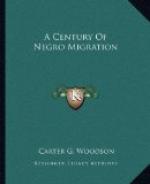[Footnote 11: Mention was thereafter made of slaves as in the case of Captain Philip Pittman who in 1770 wrote of one Mr. Beauvais, “who owned 240 orpens of cultivated land and eighty slaves; and such a case as that of a Captain of a militia at St. Philips, possessing twenty blacks; and the case of Mr. Bales, a very rich man of St. Genevieve, Illinois, owning a hundred Negroes, beside having white people constantly employed.”—See Captain Pittman’s The Present State of the European Settlements in the Mississippi, 1770.]
[Footnote 12: Dunn, Indiana, chap. vi.]
[Footnote 13: Hinsdale, Old Northwest, p. 350.]
[Footnote 14: Tyrannical Libertymen, pp. 10, 11; Locke, Anti-Slavery, pp. 31, 32; Brannagan, Serious Remonstrance, p. 18.]
[Footnote 15: Washington edition of Jefferson’s Writings, chap. vi, p. 456, and chap. viii, p. 380.]
[Footnote 16: Ford edition of Jefferson’s Writings, III, p. 244; IX, p. 303; X, pp. 76, 290.]
[Footnote 17: Brannagan, Serious Remonstrances, p. 18.]
[Footnote 18: Library edition of Jefferson’s Writings, X, pp. 295, 296.]
[Footnote 19: Adams, Neglected Period of Anti-Slavery, pp. 129, 130.]
[Footnote 20: The Pennsylvania Gazette, July 31, 1746.]
[Footnote 21: The Maryland Gazette, March 20, 1755.]
[Footnote 22: Washington’s Writings, II, p. 134.]
[Footnote 23: Brissot de Warville, New Travels, II, pp. 33-34.]
[Footnote 24: Harris, Slavery in Illinois, chaps. iii, iv, and v; Dunn, Indiana, pp. 218-260; Hinsdale, Old Northwest, pp. 351-358.]
[Footnote 25: This code provided that all male Negroes under fifteen, years of age either owned or acquired must remain in servitude until they reached the age of thirty-five and female slaves until thirty-two. The male children of such persons held to service could be bound out for thirty years and the female children for twenty-eight. Slaves brought into the territory had to comply with contracts for terms of service when their master registered them within thirty days from the time he brought them into the territory. Indentured black servants were not




